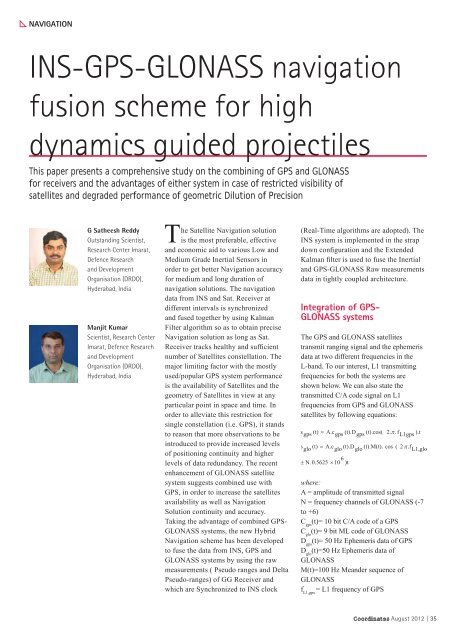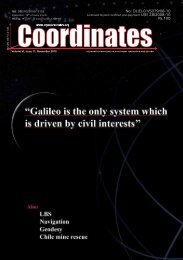Download - Coordinates
Download - Coordinates
Download - Coordinates
You also want an ePaper? Increase the reach of your titles
YUMPU automatically turns print PDFs into web optimized ePapers that Google loves.
NAVIGATION<br />
INS-GPS-GLONASS navigation<br />
fusion scheme for high<br />
dynamics guided projectiles<br />
This paper presents a comprehensive study on the combining of GPS and GLONASS<br />
for receivers and the advantages of either system in case of restricted visibility of<br />
satellites and degraded performance of geometric Dilution of Precision<br />
G Satheesh Reddy<br />
Outstanding Scientist,<br />
Research Center Imarat,<br />
Defence Research<br />
and Development<br />
Organisation (DRDO),<br />
Hyderabad, India<br />
Manjit Kumar<br />
Scientist, Research Center<br />
Imarat, Defence Research<br />
and Development<br />
Organisation (DRDO),<br />
Hyderabad, India<br />
The Satellite Navigation solution<br />
is the most preferable, effective<br />
and economic aid to various Low and<br />
Medium Grade Inertial Sensors in<br />
order to get better Navigation accuracy<br />
for medium and long duration of<br />
navigation solutions. The navigation<br />
data from INS and Sat. Receiver at<br />
different intervals is synchronized<br />
and fused together by using Kalman<br />
Filter algorithm so as to obtain precise<br />
Navigation solution as long as Sat.<br />
Receiver tracks healthy and suffi cient<br />
number of Satellites constellation. The<br />
major limiting factor with the mostly<br />
used/popular GPS system performance<br />
is the availability of Satellites and the<br />
geometry of Satellites in view at any<br />
particular point in space and time. In<br />
order to alleviate this restriction for<br />
single constellation (i.e. GPS), it stands<br />
to reason that more observations to be<br />
introduced to provide increased levels<br />
of positioning continuity and higher<br />
levels of data redundancy. The recent<br />
enhancement of GLONASS satellite<br />
system suggests combined use with<br />
GPS, in order to increase the satellites<br />
availability as well as Navigation<br />
Solution continuity and accuracy.<br />
Taking the advantage of combined GPS-<br />
GLONASS systems, the new Hybrid<br />
Navigation scheme has been developed<br />
to fuse the data from INS, GPS and<br />
GLONASS systems by using the raw<br />
measurements ( Pseudo ranges and Delta<br />
Pseudo-ranges) of GG Receiver and<br />
which are Synchronized to INS clock<br />
(Real-Time algorithms are adopted). The<br />
INS system is implemented in the strap<br />
down confi guration and the Extended<br />
Kalman fi lter is used to fuse the Inertial<br />
and GPS-GLONASS Raw measurements<br />
data in tightly coupled architecture.<br />
Integration of GPS-<br />
GLONASS systems<br />
The GPS and GLONASS satellites<br />
transmit ranging signal and the ephemeris<br />
data at two different frequencies in the<br />
L-band. To our interest, L1 transmitting<br />
frequencies for both the systems are<br />
shown below. We can also state the<br />
transmitted C/A code signal on L1<br />
frequencies from GPS and GLONASS<br />
satellites by following equations:<br />
where:<br />
A = amplitude of transmitted signal<br />
N = frequency channels of GLONASS (-7<br />
to +6)<br />
C gps (t)= 10 bit C/A code of a GPS<br />
C glo (t)= 9 bit ML code of GLONASS<br />
D gps (t)= 50 Hz Ephemeris data of GPS<br />
D glo (t)=50 Hz Ephemeris data of<br />
GLONASS<br />
M(t)=100 Hz Meander sequence of<br />
GLONASS<br />
f L1,gps = L1 frequency of GPS<br />
<strong>Coordinates</strong> August 2012 | 35
















